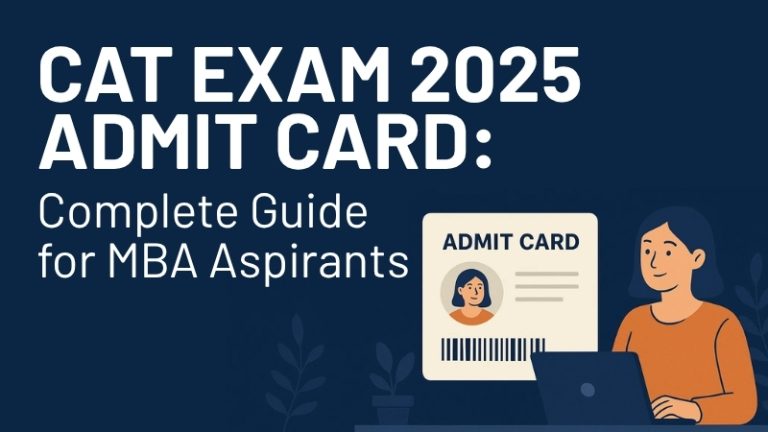Mock tests are the key to CAT success. They sharpen time management, accuracy, and exam strategy. Learn when to start, how to attempt, and effectively analyze mocks to identify weaknesses, boost percentile, and build confidence for the CAT 2025 exam.
Mock Tests in CAT Preparation: The Blueprint for Success

For many aspirants, mock tests are a dreaded yet indispensable part of CAT preparation. Some avoid them out of fear of low scores, while others take them without proper analysis, hoping mere exposure will improve performance. The truth is that mock tests are the single most powerful tool in CAT preparation
—not because they boost knowledge directly, but because they sharpen strategy, time management, and accuracy. In fact, the journey from an average 80th percentile to a 99th percentile often hinges on how well aspirants use mock tests.
This article explores not only how often one should take mocks but, more importantly, how to analyze them to derive maximum benefit.
Why Mock Tests Are Crucial
CAT is not just a test of knowledge; it is a test of decision-making under pressure. A candidate with strong concepts may still underperform if they lack time management skills or if they fall into psychological traps during the exam. Mock tests simulate the actual exam environment and help aspirants:
- Develop a question selection strategy.
- Learn how to handle sectional time limits effectively.
- Build familiarity with the computer-based testing interface.
- Understand how stamina and focus vary over two hours.
- Gauge percentile projections and benchmark against peers (if using coaching mocks).
In short, mocks convert preparation from theory into practice.
When to Start Taking Mocks
The ideal time to begin attempting mock tests is three to four months before the exam. Early mocks can be intimidating, especially if scores are low, but they provide a baseline. Even a 50th percentile score in the first few mocks is valuable because it highlights where improvement is required.
For beginners:
- Start with 1 mock every 2 weeks in the initial phase.
- Gradually increase to 1 per week once concepts are covered.
- From September onwards, attempt 2–3 mocks per week consistently until exam day.
How to Attempt a Mock Test
When attempting mocks, aspirants should simulate the real exam-day environment as closely as possible:
- Sit in a quiet place, without distractions.
- Stick strictly to the 120-minute time limit.
- Do not pause, skip, or “cheat” by looking up solutions.
- After completion, note down immediate reflections: Which section felt hardest? Which questions drained time?
This discipline ensures that the mock provides true insights into readiness.
The Art of Mock Test Analysis
Many aspirants make the mistake of moving from one mock to another without deep analysis. The real improvement happens after the mock, not during it. Effective analysis involves:
- Accuracy Check
- Categorize each question as: Correct, Incorrect, or Unattempted.
- Identify careless mistakes versus genuine lack of knowledge.
- Categorize each question as: Correct, Incorrect, or Unattempted.
- Time Analysis
- Which questions consumed more than 3 minutes unnecessarily?
- Where was guessing used without logic?
- Which questions consumed more than 3 minutes unnecessarily?
- Sectional Strategy
- Did you start with the right questions?
- Were weaker areas ignored or attempted inefficiently?
- Did you start with the right questions?
- Error Log
- Maintain a notebook of frequent errors. For example, “misread question in RC,” “confused ratio with percentage,” “wasted time on unsolvable puzzle.” Reviewing this log weekly helps avoid repeating mistakes.
- Maintain a notebook of frequent errors. For example, “misread question in RC,” “confused ratio with percentage,” “wasted time on unsolvable puzzle.” Reviewing this log weekly helps avoid repeating mistakes.
- Learning from Missed Questions
- Attempt every unattempted and incorrect question again without time limits. This reinforces learning and builds confidence.
- Attempt every unattempted and incorrect question again without time limits. This reinforces learning and builds confidence.
Section-Wise Mock Insights
- VARC: Check accuracy in RC questions. If wrong answers are frequent, the issue may be misinterpretation of the author’s tone rather than vocabulary gaps.
- DILR: Focus on set selection. Were you drawn to a difficult puzzle when an easier one existed?
- QA: Identify if errors are due to conceptual gaps or time mismanagement. Often, skipping 1–2 tough questions early can save time for 3–4 easier ones later.
Balancing Mock Tests with Preparation
Mocks should not overwhelm daily study routines. The key is to balance practice with analysis. A suggested cycle is:
- First Day (Day 1): Attempt full mock.
- Second Day (Day 2): Analyze in detail (4–5 hours).
- Day 3–6: Practice weaker areas identified in the mock.
- Day 7: Sectional test or targeted practice before the next mock.
This approach ensures that each mock is a learning milestone rather than just another score.
Psychological Aspects of Mocks
Low scores in the early stages often discourage aspirants. It is vital to understand that mock scores are not final indicators; they are diagnostic tools. Many aspirants who scored 70–80th percentile in June ended up in the 99th percentile in November simply because they used mock insights effectively.
Equally important is avoiding overconfidence after a few high scores. Mock performance fluctuates, and the goal should be consistency and adaptability, not isolated highs.
Frequently Asked Questions (FAQ)
Q1. How many mock tests are enough for CAT preparation?
Most serious aspirants attempt 25–40 mocks before CAT, with detailed analysis after each one.
Q2. Should I take mocks even if my syllabus is not complete?
Yes. Early mocks help identify weaknesses and provide direction for what to focus on next.
Q3. How long should I spend analyzing a mock?
At least 3–4 hours. Ideally, double the time spent on the test itself should be dedicated to analysis.
Q4. My scores fluctuate a lot across mocks. Is that normal?
Yes. Variability is expected due to different difficulty levels and strategies. What matters is identifying a trend of improvement over time.
Q5. Should I take mocks from multiple coaching institutes?
Yes, if possible. Different institutes (TIME, IMS, CL) design mocks with varying difficulty, which provides broader exposure.













